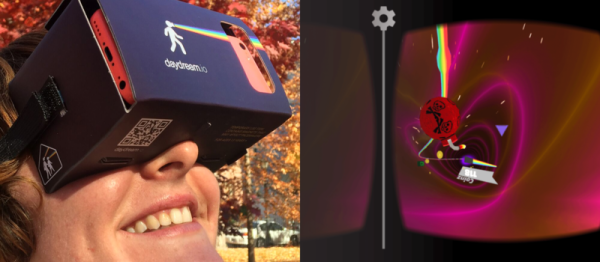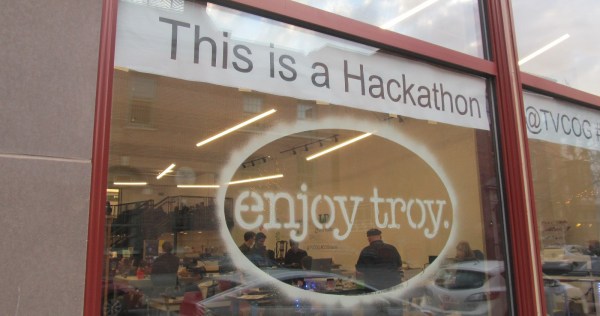We mentioned last week how robotaxi provider Cruise was having a no-good, very bad week, after one of their driverless taxis picked a fight with a semi, and it was revealed that amorous San Franciscans were taking advantage of the privacy afforded by not having a driver in the front seat. It appears that we weren’t the only ones to notice all the bad news, since California’s Department of Motor Vehicles issued an order to the company to cut its robotaxi fleet in half. The regulatory move comes after a recent Cruise collision with a fire truck, which injured a passenger in the taxi. Curiously, the DMV order stipulates that Cruise can only operate 50 vehicles during the day, while allowing 150 vehicles at night. We’d have thought the opposite would make more sense, since driving at night is generally more difficult than during daylight hours. But perhaps the logic is that the streets are less crowded at night, whereas daytime is a more target-rich environment.
TVCOG6 Articles
Hackathon Alert: Clean Tech At TVCoG
At Hackaday, we get notified of a lot of the cool events going on in hackerspaces all around the world. We’d like to keep you informed too, just in case there’s something going on in your neighborhood.
So we’re going to start running a weekly column on Saturdays that groups together all of the upcoming week’s exceptional events and noteworthy gatherings. If your hackerspace has something going on, tell us about your event on or around the preceding Wednesday. We’ll see your space in on Hackaday!
Continue reading “Hackathon Alert: Clean Tech At TVCoG”
Get Your Game On: Troy’s TVCoG Hosts VR And Gaming Hackathon
Troy New York’s Tech Valley Center of Gravity is following up their January IoT Hackathon with another installment. The April 16-17 event promises to be a doozy, and anyone close to the area with even a passing interest in gaming and AR/VR should really make an effort to be there.
Not content to just be a caffeine-fueled creative burst, TVCoG is raising the bar in a couple ways. First, they’re teaming up with some corporate sponsors with a strong presence in the VR and AR fields. 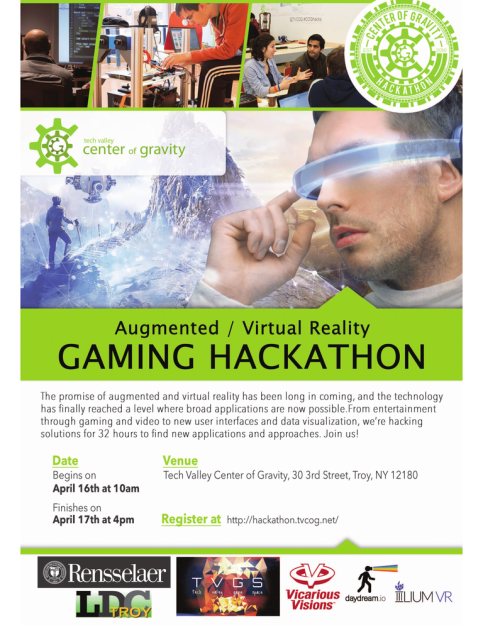 Daydream.io, a new company based in the same building as the CoG, is contributing a bunch of its Daydream.VR smartphone headsets to hackathon attendees, as well as mentors to get your project up and running. Other sponsors include 1st Playable Productions and Vicarious Visions, game studios both located in the Troy area. And to draw in the hardcore game programmers, a concurrent Ludum Dare game jam will be run by the Tech Valley Game Space, with interaction and collaboration between the AR/VR hackers and the programmers encouraged. Teams will compete for $1000 in prizes and other giveaways.
Daydream.io, a new company based in the same building as the CoG, is contributing a bunch of its Daydream.VR smartphone headsets to hackathon attendees, as well as mentors to get your project up and running. Other sponsors include 1st Playable Productions and Vicarious Visions, game studios both located in the Troy area. And to draw in the hardcore game programmers, a concurrent Ludum Dare game jam will be run by the Tech Valley Game Space, with interaction and collaboration between the AR/VR hackers and the programmers encouraged. Teams will compete for $1000 in prizes and other giveaways.
This sounds like it’s going to be an amazing chance to hack, to collaborate, and to make connections in the growing AR/VR field. And did we mention the food? There was a ton of it last time, so much they were begging us to take it home on Sunday night. Go, hack, create, mingle, and eat. TVCoG knows how to hackathon, and you won’t be disappointed.
Thanks to [Duncan Crary] for the heads up on this.
This Is How You Run A Hackathon: Tech Valley Center Of Gravity
What’s not to love about a hackathon? The junk food and caffeine that fuel the weekend; the highs that come with success and the lows that come when the blue smoke is released; the desperate search for inspiration as the clock ticks away; nerve-wracking pitches to the judges, hoping against hope that everything works in the demo. Hackathons are the contact sport of the hacker world, bringing in top competitors and eager upstarts, and when done well you just might attract interested “civilians” and other newbies that will catch the hacking bug from what they witness.
Such was the scene at the Tech Valley Center of Gravity in Troy, NY over the last weekend of January. New for 2016, the CoG is hosting a series of four hardware hackathons this year, each with a different theme. This event’s theme was “Internet of Things”, and the call went out to any and all to come compete for bragging rights and over $1,000 in prizes. Incentives to compete included some big name corporate sponsors, like AT&T, and judging and mentoring provided by the likes of SparkFun’s [Jeff Branson]. There was also a steady stream of food and drink, saturation coverage by local media outlets, and your humble Hackaday writer and his son, who made the trip up to Troy with a small passel of Hackaday swag and a curiosity to see how the CoG has fared since our last visit at the grand opening of their glorious new home. We were not disappointed.
Continue reading “This Is How You Run A Hackathon: Tech Valley Center Of Gravity”
SparkFun, AT&T To Sponsor Hackathon At Troy’s TVCoG
Big-name corporate sponsors, top-notch judges and mentoring, 36 hours to play in a huge new hackerspace, and all the Cheetos and Red Bull you need to stoke the creative fires. Sounds like a hackathon, and it’ll roll into The Tech Valley Center of Gravity in Troy, New York next month. And from the look of it, it’s going to be a big deal. You should be there.
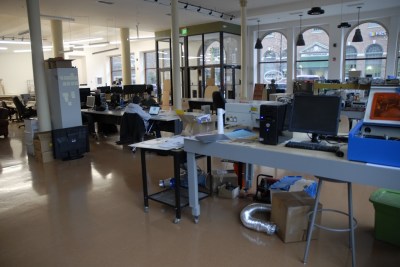 You might recall the TVCoG from a story we did this summer on the grand opening of their amazing newly renovated space in downtown Troy. Occupying an entire city block in a historic department store building and housing not only a huge hackerspace but a tech company incubator with manufacturing capabilities and a STEM outreach space, the CoG now has the room to reach out into the community and host big events. The hackathon scheduled for January 30 and 31 and is only the first of four events planned for 2016. This one has the theme “Internet of Things” and will feature SparkFun’s Jeff Branson as mentor and judge.
You might recall the TVCoG from a story we did this summer on the grand opening of their amazing newly renovated space in downtown Troy. Occupying an entire city block in a historic department store building and housing not only a huge hackerspace but a tech company incubator with manufacturing capabilities and a STEM outreach space, the CoG now has the room to reach out into the community and host big events. The hackathon scheduled for January 30 and 31 and is only the first of four events planned for 2016. This one has the theme “Internet of Things” and will feature SparkFun’s Jeff Branson as mentor and judge.
Here’s a call to arms for Hackaday readers in the northeast: let’s pack this hackathon and make it huge. There’s already a bunch of Jolly Wrencher stickers scattered all over from our last visit, so you’ll feel right at home. Head over to the TVCoG site and sign up for this one. We’d really like to see HaD take home bragging rights. And you can be sure we’ll be covering the event and bringing some swag of our own.
[Thanks to Duncan Crary for the tip!]
Tech Valley Center Of Gravity Helped Turn The City Around
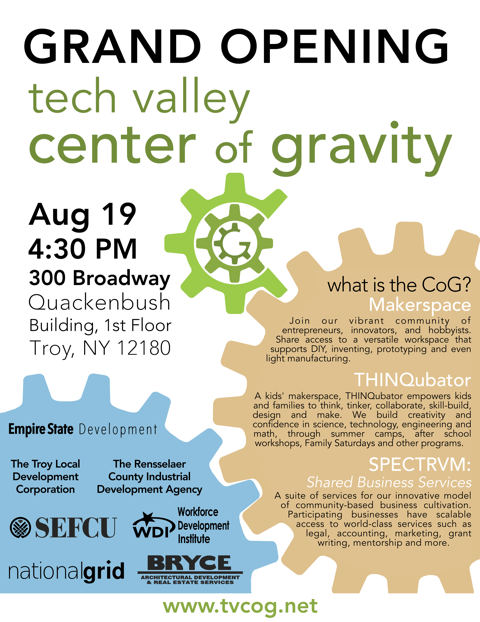 Last week we got an invitation in the Hackaday tip line to attend the grand opening of a hackerspace in Troy, New York. Styling itself the Tech Valley Center of Gravity, the group seemed intriguing – a combination of makerspace and business incubator. But what was this about a grand opening? Hackerspaces don’t open – they just occupy a found space and grow by accretion until they reach a critical mass of equipment and awesomeness. I decided I needed to see this for myself, and being only a two-hour drive from my home, I headed off with my kids in tow and a small pile of Hackaday swag to see what a ribbon cutting for a hackerspace would be like. Plus I absolutely had to find out what in the world a “Quackenbush Building” was.
Last week we got an invitation in the Hackaday tip line to attend the grand opening of a hackerspace in Troy, New York. Styling itself the Tech Valley Center of Gravity, the group seemed intriguing – a combination of makerspace and business incubator. But what was this about a grand opening? Hackerspaces don’t open – they just occupy a found space and grow by accretion until they reach a critical mass of equipment and awesomeness. I decided I needed to see this for myself, and being only a two-hour drive from my home, I headed off with my kids in tow and a small pile of Hackaday swag to see what a ribbon cutting for a hackerspace would be like. Plus I absolutely had to find out what in the world a “Quackenbush Building” was.
I was not disappointed. The Center of Gravity is a really special group of folks with an incredible vision of what it means to be hackers. Hackerspaces make a lot of things – great projects and gadgetry, plus sawdust, metal chips, and the occasional puff of Magic Blue Smoke. The Center of Gravity makes all of that, but it also makes entrepreneurs, businesses, and actual products. And it can reasonably claim to have a hand in community renewal.
The Quackenbush
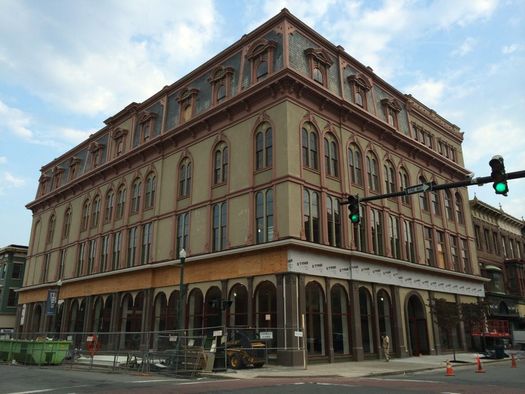
Disappointed, I headed down the stairs to the basement, which was mercifully cooler than the first floor. Ah, ha! Here were the shops – huge and brand new, with separate areas for woodwork and metalwork. And here I met [Bob Bownes], vice president of CoG, serial entrepreneur, and the fellow who invited me. And this is where I finally learned the full story of what was going on.

The ribbon cutting that was going on upstairs – the ribbon being a copper braid and the scissors being a MIG welder – was the official start of the CoG’s residency in its new space in the renovated Quackenbush Building. Built in the 1850s, it was home to the Quackenbush Department Store until the 1930s, when it switched hands to another chain. It finally became a Rite Aid pharmacy which, in a sign of the hard times Troy would fall upon, closed in the early 2000s. The beautiful old building was purchased by a local developer, renovated with the help of various state grants, and its 48,000 square feet were turned over to the CoG group, who could now move out of their cramped and confining home in the bottom of a parking garage that was once a McDonald’s and an off-track betting parlor.
Making Businesses
It wasn’t just good fortune that lead to the CoG being able to expand so dramatically. As [Bob] explained, the CoG had been designed from the ground up to be a business incubator as well as a hackerspace. If you have an idea, you can turn it into a product in the CoG hackerspace, then turn the product into a business in the incubator. The upper two floors of the Quackenbush are devoted to the incubator, which provides fledgling companies with access to administrative functions, provides conference and office space, and helps get businesses off the ground.
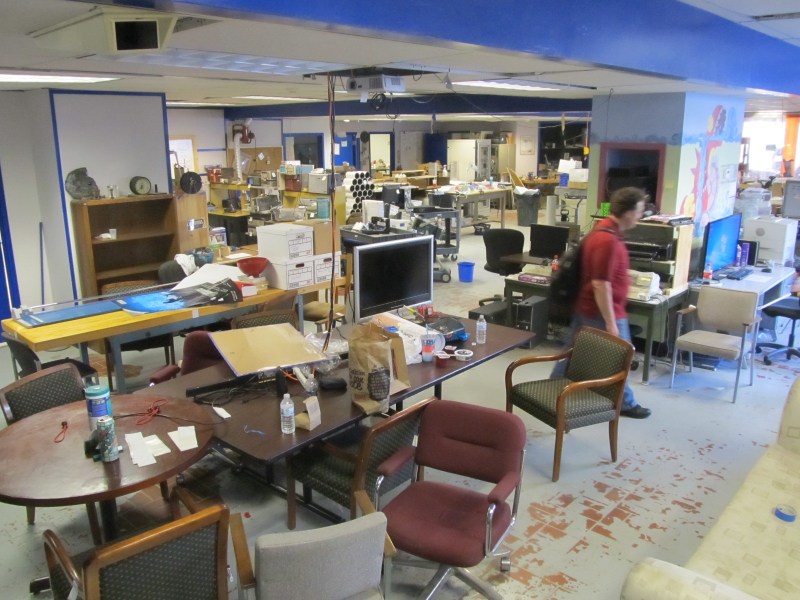
One such business is Vital Vio, a maker of visible light disinfection fixtures. Vital Vio got its start in the aforementioned former McDonald’s, and will take advantage of the 3,000 square foot light manufacturing swing space in the basement of the Quackenbush to ramp up its production. The goal is to have Vital Vio and the companies that will no doubt follow it move on to space of their own, at which point the next company will take over the swing space for their first manufacturing operation – hack, rinse, repeat. With quite a few businesses already in the incubator stage, it should be exciting to watch what comes out of the CoG over the next few years.
Making Community
I had been to Troy a few times back in the ’80s and ’90s, and I wasn’t impressed. It always seemed seedy and run down to me, like so many towns and cities in the northeast US that had their manufacturing hearts ripped out of them in the 1970s. But the Troy we saw on Wednesday was a totally different place – vital and happening, with bistros and bakeries and funky public spaces. [Bob] explained that CoG had plenty to do with that – at least six new companies had relocated to the area around the Quackenbush specifically because of CoG. And it’s hoped that the businesses that spin off the incubator will choose to stay close to the nest, which will attract more businesses and more people to the area. That’s quite a change from the point where even a McDonald’s and an off-track betting parlor are no longer viable.
My trip to the Tech Valley Center of Gravity was not your typical hackerspace tour, but the CoG is not your typical hackerspace. There’s a lot to be said for the vision that created this place, and the model they’ve adopted for churning out businesses really seems to be working. Almost the entire incubator space is spoken for already, so there are plenty of companies waiting to be born there. That’s not to say that the average hacker who just wants a place to play won’t feel at home in the CoG – there’s plenty of room for them too, and the CoG even welcomes families with special memberships and STEM outreach programs. But if you have the germ of an idea, it can go from product to business with the help of a place like this, and that’s a pretty cool idea.
My thanks to [Bob], [Matt] and [Tait] for taking so much time out of their celebration to show us around. I hope we can visit again once everything is moved and you’re settled into your awesome new home.



